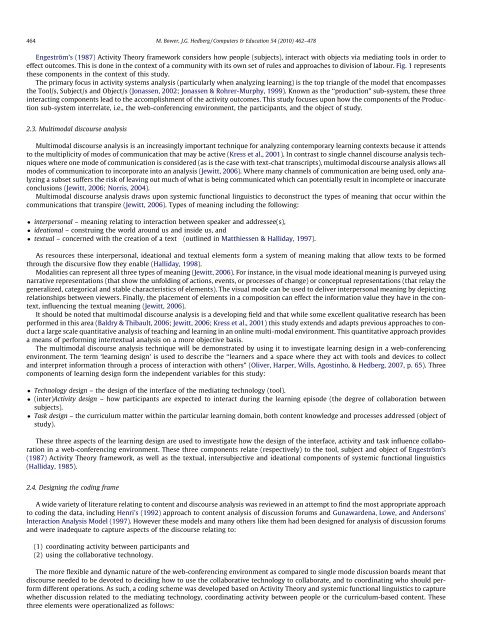A quantitative multimodal discourse analysis of ... - Anitacrawley.net
A quantitative multimodal discourse analysis of ... - Anitacrawley.net
A quantitative multimodal discourse analysis of ... - Anitacrawley.net
You also want an ePaper? Increase the reach of your titles
YUMPU automatically turns print PDFs into web optimized ePapers that Google loves.
464 M. Bower, J.G. Hedberg / Computers & Education 54 (2010) 462–478Engeström’s (1987) Activity Theory framework considers how people (subjects), interact with objects via mediating tools in order toeffect outcomes. This is done in the context <strong>of</strong> a community with its own set <strong>of</strong> rules and approaches to division <strong>of</strong> labour. Fig. 1 representsthese components in the context <strong>of</strong> this study.The primary focus in activity systems <strong>analysis</strong> (particularly when analyzing learning) is the top triangle <strong>of</strong> the model that encompassesthe Tool/s, Subject/s and Object/s (Jonassen, 2002; Jonassen & Rohrer-Murphy, 1999). Known as the ‘‘production” sub-system, these threeinteracting components lead to the accomplishment <strong>of</strong> the activity outcomes. This study focuses upon how the components <strong>of</strong> the Productionsub-system interrelate, i.e., the web-conferencing environment, the participants, and the object <strong>of</strong> study.2.3. Multimodal <strong>discourse</strong> <strong>analysis</strong>Multimodal <strong>discourse</strong> <strong>analysis</strong> is an increasingly important technique for analyzing contemporary learning contexts because it attendsto the multiplicity <strong>of</strong> modes <strong>of</strong> communication that may be active (Kress et al., 2001). In contrast to single channel <strong>discourse</strong> <strong>analysis</strong> techniqueswhere one mode <strong>of</strong> communication is considered (as is the case with text-chat transcripts), <strong>multimodal</strong> <strong>discourse</strong> <strong>analysis</strong> allows allmodes <strong>of</strong> communication to incorporate into an <strong>analysis</strong> (Jewitt, 2006). Where many channels <strong>of</strong> communication are being used, only analyzinga subset suffers the risk <strong>of</strong> leaving out much <strong>of</strong> what is being communicated which can potentially result in incomplete or inaccurateconclusions (Jewitt, 2006; Norris, 2004).Multimodal <strong>discourse</strong> <strong>analysis</strong> draws upon systemic functional linguistics to deconstruct the types <strong>of</strong> meaning that occur within thecommunications that transpire (Jewitt, 2006). Types <strong>of</strong> meaning including the following: interpersonal – meaning relating to interaction between speaker and addressee(s), ideational – construing the world around us and inside us, and textual – concerned with the creation <strong>of</strong> a text (outlined in Matthiessen & Halliday, 1997).As resources these interpersonal, ideational and textual elements form a system <strong>of</strong> meaning making that allow texts to be formedthrough the discursive flow they enable (Halliday, 1998).Modalities can represent all three types <strong>of</strong> meaning (Jewitt, 2006). For instance, in the visual mode ideational meaning is purveyed usingnarrative representations (that show the unfolding <strong>of</strong> actions, events, or processes <strong>of</strong> change) or conceptual representations (that relay thegeneralized, categorical and stable characteristics <strong>of</strong> elements). The visual mode can be used to deliver interpersonal meaning by depictingrelationships between viewers. Finally, the placement <strong>of</strong> elements in a composition can effect the information value they have in the context,influencing the textual meaning (Jewitt, 2006).It should be noted that <strong>multimodal</strong> <strong>discourse</strong> <strong>analysis</strong> is a developing field and that while some excellent qualitative research has beenperformed in this area (Baldry & Thibault, 2006; Jewitt, 2006; Kress et al., 2001) this study extends and adapts previous approaches to conducta large scale <strong>quantitative</strong> <strong>analysis</strong> <strong>of</strong> teaching and learning in an online multi-modal environment. This <strong>quantitative</strong> approach providesa means <strong>of</strong> performing intertextual <strong>analysis</strong> on a more objective basis.The <strong>multimodal</strong> <strong>discourse</strong> <strong>analysis</strong> technique will be demonstrated by using it to investigate learning design in a web-conferencingenvironment. The term ‘learning design’ is used to describe the ‘‘learners and a space where they act with tools and devices to collectand interpret information through a process <strong>of</strong> interaction with others” (Oliver, Harper, Wills, Agostinho, & Hedberg, 2007, p. 65). Threecomponents <strong>of</strong> learning design form the independent variables for this study: Technology design – the design <strong>of</strong> the interface <strong>of</strong> the mediating technology (tool). (inter)Activity design – how participants are expected to interact during the learning episode (the degree <strong>of</strong> collaboration betweensubjects). Task design – the curriculum matter within the particular learning domain, both content knowledge and processes addressed (object <strong>of</strong>study).These three aspects <strong>of</strong> the learning design are used to investigate how the design <strong>of</strong> the interface, activity and task influence collaborationin a web-conferencing environment. These three components relate (respectively) to the tool, subject and object <strong>of</strong> Engeström’s(1987) Activity Theory framework, as well as the textual, intersubjective and ideational components <strong>of</strong> systemic functional linguistics(Halliday, 1985).2.4. Designing the coding frameA wide variety <strong>of</strong> literature relating to content and <strong>discourse</strong> <strong>analysis</strong> was reviewed in an attempt to find the most appropriate approachto coding the data, including Henri’s (1992) approach to content <strong>analysis</strong> <strong>of</strong> discussion forums and Gunawardena, Lowe, and Andersons’Interaction Analysis Model (1997). However these models and many others like them had been designed for <strong>analysis</strong> <strong>of</strong> discussion forumsand were inadequate to capture aspects <strong>of</strong> the <strong>discourse</strong> relating to:(1) coordinating activity between participants and(2) using the collaborative technology.The more flexible and dynamic nature <strong>of</strong> the web-conferencing environment as compared to single mode discussion boards meant that<strong>discourse</strong> needed to be devoted to deciding how to use the collaborative technology to collaborate, and to coordinating who should performdifferent operations. As such, a coding scheme was developed based on Activity Theory and systemic functional linguistics to capturewhether discussion related to the mediating technology, coordinating activity between people or the curriculum-based content. Thesethree elements were operationalized as follows:
















